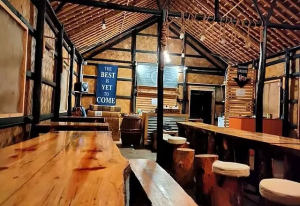On World Pizza Day, here is the journey of this beloved dish—from its humble origins to global fame. With surprising Indian roots and endless fusion flavours, pizza unites cultures and cravings. Jnanendra Das brings the story of Shillong’s only wood-fired pizzeria, Pizza Barn, where tradition meets innovation, one slice at a time.

There’s something about pizza that evokes nostalgia. As adults, one can have as many slices as they want, yet nothing quite compares to those childhood birthday parties, where a single or two pizzas had to be shared among eager hands. The thrill of grabbing a slice before it was gone, the taste made richer by laughter and friendly squabbles.

Pizza is more than just food; it is a phenomenon. A global favourite, it is round in shape, cut into triangular slices, and served in a rectangular box—an amusing yet scientific design. Though its origins trace back to Italy, India has embraced pizza with open arms, adding its own flair with local flavours, cheese, and protein-packed toppings. However, there is an even deeper, often-overlooked connection between India and this beloved dish: mozzarella cheese.
Modern pizza, as we know it, is said to have originated in Naples, Italy. Flatbreads had been common in the Mediterranean for centuries, with the ancient Greeks enjoying different variations. One of the precursors to pizza was the focaccia, a flatbread known to the Romans as panis focacius. Toppings were later added to enhance the flavour.
The word “pizza” is believed to have originated from the Latin pinso, meaning “to beat or pound,” or from the Greek pitta, meaning a flatbread or pie.
Despite its popularity today, pizza was initially considered food for the poor. Tomatoes, now an essential ingredient, were once thought to be poisonous in Italy and were avoided. It wasn’t until the 18th century that both tomatoes and mozzarella became central to pizza-making.
 Mozzarella, primarily made from buffalo milk, traces its origins to India, where water buffaloes were first domesticated. These animals were traded to Italy some 1400 years back via a long route through Mesopotamia during the Indus Valley Civilisation. (Source: Sharkalisharri seal, Louvre Museum)
Mozzarella, primarily made from buffalo milk, traces its origins to India, where water buffaloes were first domesticated. These animals were traded to Italy some 1400 years back via a long route through Mesopotamia during the Indus Valley Civilisation. (Source: Sharkalisharri seal, Louvre Museum)
The rich milk led to the creation of mozzarella di bufala, named after the Italian word mozzare (to cut).
The popularity of pizza skyrocketed when the local aristocracy developed a taste for it. The first official pizzeria opened in 1830, and by 1889, Queen Margherita of Italy had her own patriotic pizza. According to popular legends, a Neapolitan pizzaiolo, Raffaele Esposito, created a special pizza for her with mozzarella, basil, and tomatoes—representing the colours of the Italian flag. This creation was named Pizza Margherita, and the rest is history. (Source: Cucina Napoletana: 100 Recipes from Italy’s Most Vibrant City by Arturo Iengo)
Pizza’s journey beyond Italy was largely driven by migration. In the late 19th and early 20th centuries, Italian immigrants carried their culinary traditions across the world. By the 1950s, American corporate giants recognised the potential of pizza and introduced deep-dish, thick-crust varieties. The 1980s saw the rise of gourmet California-style pizza, featuring exotic toppings like crème fraiche and caviar.

Today, pizza is as diverse as the cultures that have embraced it. In Korea, one can find pizzas topped with kimchi, while Japan offers salmon teriyaki pizza. India, true to its love for bold flavours, boasts toppings such as chicken tikka, paneer tikka, and even bhoot jolokia (ghost pepper) for the adventurous eater.
Pizza Barn
In Shillong, pizza has taken on a local identity, thanks to entrepreneurs like Emisouwi Moore Mihsill and Lapdiang H. Dympep, co-founders of Pizza Barn. Opened in September 2019, Pizza Barn is Shillong’s first wood-fired pizzeria, located in the midst of a serene pine forest in Mawlai Umshing. The restaurant’s vernacular architectural design—a traditional hut built with straw and bamboo—adds a rustic charm that sets it apart.
Pizza Barn was founded with a vision to address unemployment in Meghalaya by encouraging entrepreneurship. According to Mihsill, their goal was to create new opportunities and elevate the local food scene. They specialise in authentic, freshly baked thin-crust pizzas, offering massive 14” and 18” sizes—the first of their kind in Northeast India.
Unlike conventional pizzerias, Pizza Barn incorporates indigenous North Eastern flavours into its menu. Some of their signature pizzas include:
-
Doh Neiiong Pizza – featuring pork cooked with black sesame seeds
-
Smoked Pork Pizza – highlighting traditional smoking techniques
-
Dohkhleh Pizza – inspired by the Khasi pork salad
-
Naga-Style Pizza – bringing in spicy, smoky flavours from Nagaland
-
Mint and Green Chillies Pizza – a refreshing, fiery take on pizza
Shillong’s love for pork and chillies needs no mention and Pizza Barn has embraced this passion by offering pizzas that pack a punch. From the fiery bhoot jolokia pizza to the pork with bamboo shoot pizza, their menu is a testament to Meghalaya’s rich culinary heritage.

Sharing their reviews with the Pizza Barn, Neelakshi Chakraborty raves, “They serve the best pizzas. Hands down! It holds the potential to be the best in the entire world.”
Raynald Donn Marbaniang shares, “My experience was very nerve-calming, coming onto this barn, having my favourite choice of pizza with my partner. It offers a rooted and cosy ambience and is perfect for a pit stop if you’re travelling through that area. It is located in a forested place on the main road, making it easy and convenient for anyone.”
A tourist from Delhi wrote, “If ever you crave authentic wood-fired pizzas outside of Italy or New York and with a local twist, this is the place to be. Outstanding taste is what I would rate this place. Nestled amidst fragrant pine groves, on the outskirts of Shillong city, the restaurant has a rustic country feel with split bamboo walls, a thatch roof, log tables, and benches. They also make a mean fresh fruit punch to go with the pizzas. A must-visit place! Be prepared to wait for your table, especially on weekends and holidays.”

Pizza’s evolution from an ignoble flatbread to a global food mirrors the way cuisine blends and adapts. While Italians consider only two types of pizza- Italian and non-Italian, countries worldwide have put their unique spin on it. Shillong’s Pizza Barn exemplifies this fusion, merging traditional Italian techniques with local ingredients to create something truly special.
Food is indeed a soft power. Even in places where cultural exchanges are limited, pizza has made its mark. North Korea, known for its isolation, opened its first pizzeria in Pyongyang in 2009, demonstrating the universal appeal of this dish. Pizza is meant to be shared. Whether in New York, Naples, or Shillong, pizza continues to be a unifying force, connecting people across continents, one delicious slice at a time.



